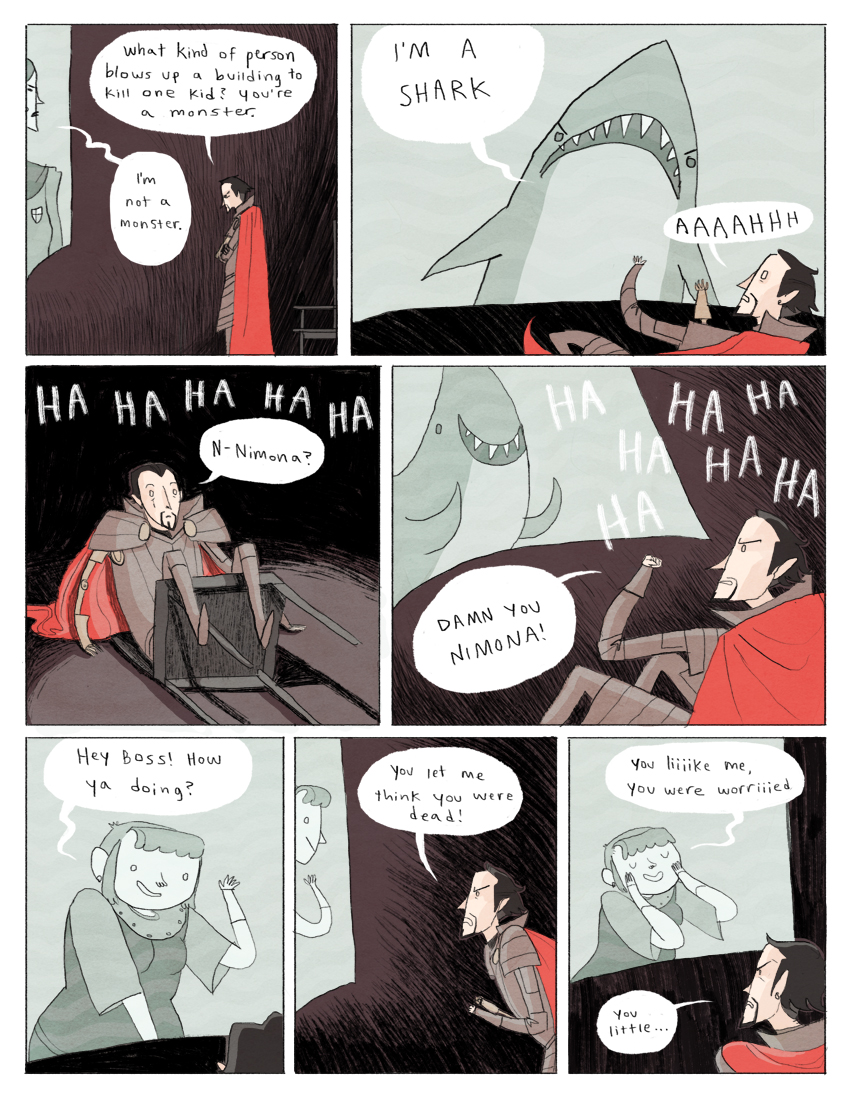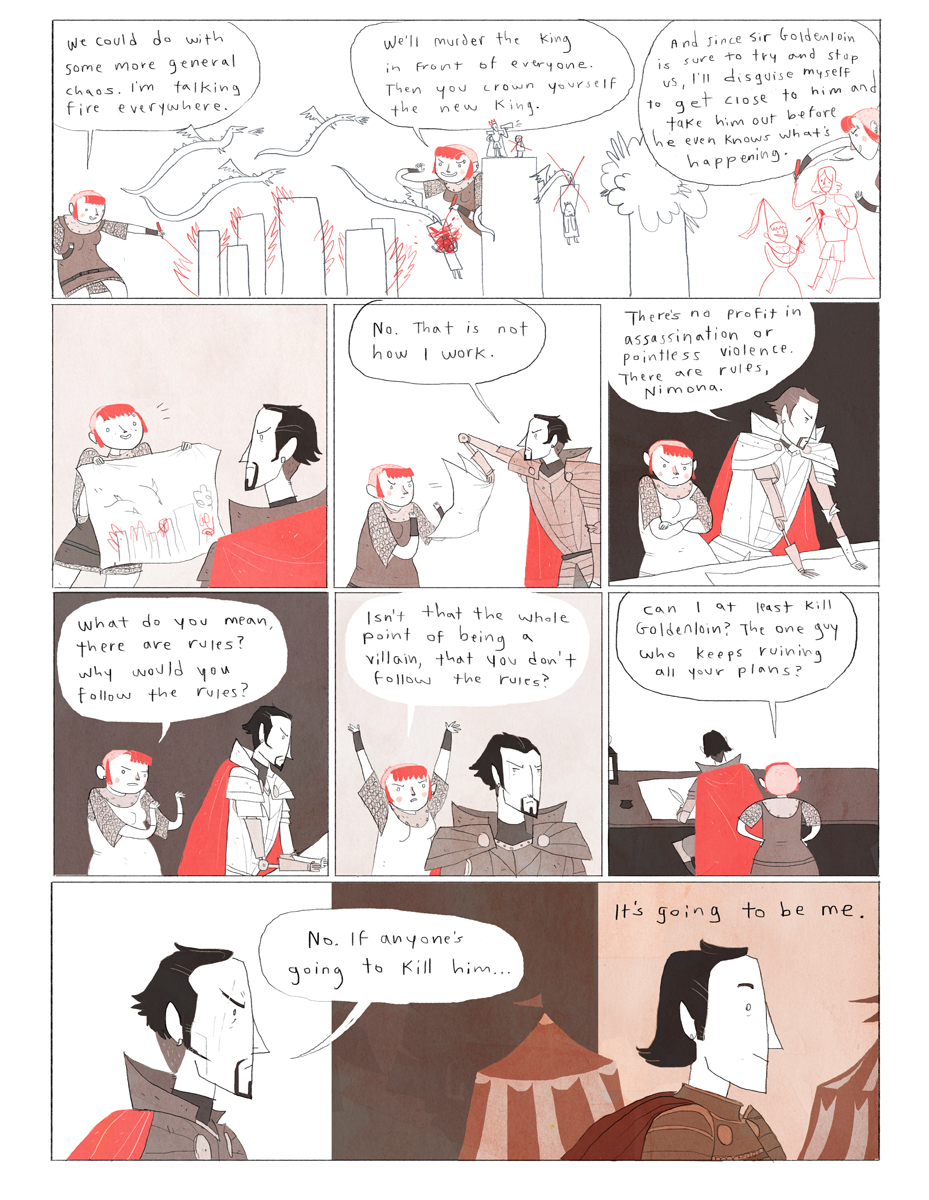Noelle Stevenson’s Nimona and the Destruction of Expectations
We look at the collection of the Lumberjanes writer's Harvey nominated webcomic
One of the strange things about my work is I’m always writing in my head even when not actually writing. That may not really be weird – everyone may do it, so I may be completely ordinary – but for me, it means that when I sit down to write about something after my research phase, it’s really just a formality. I know what I am going to say before I sit down, and what comes out is pre-ordained in a way. Time is a flat circle, and an article was and is always written for me. It’s nice, as writing like that means even my longform articles typically only take about an hour or so for me to write (I also type very fast). It allows me to manage SKTCHD without needing to sacrifice living an ordinary life.
Recently, I bought the hardback collection of Noelle Stevenson’s webcomic Nimona with the intention of reviewing it. When I sat down and read the first few chapters, I had a pretty good idea of the things I might say as I am wont to do. I would talk about how charming and fun it is, and how Stevenson’s story felt like a blend of the smart irreverence of Ryan Q. North’s writing with the style and storytelling of Kate Beaton’s cartooning. In fact, early on, it reminded me a lot of Beaton’s brilliant Nemesis story in Hark! A Vagrant, I’d say. I’d look at how it was an imaginative and hilarious twist on a tale we’ve experienced before, and it worked well because of the chops Stevenson has as a creator.
I was absolutely ready to say all of that. All I had to do was read the rest of the book.
Then I did, and all of that went out the window.
 Nimona the book is a lot like its titular co-lead. While their exterior and early experiences foretell one thing, the reality of both the book and its heroine of sorts is a lot more complex and unpredictable. That unpredictable nature helps the book transcend from the well-crafted and amusing read it is early on to a much more rich, unique and altogether memorable book, and further establishes Stevenson as one of comics brightest young voices.
Nimona the book is a lot like its titular co-lead. While their exterior and early experiences foretell one thing, the reality of both the book and its heroine of sorts is a lot more complex and unpredictable. That unpredictable nature helps the book transcend from the well-crafted and amusing read it is early on to a much more rich, unique and altogether memorable book, and further establishes Stevenson as one of comics brightest young voices.
I know, bold statement. She just won enough Eisners as part of Team Lumberjanes that she may have had to buy an additional suitcase as she departed San Diego. But Nimona is one of those reads that comes together only once in every while, and in its full collected form, delivers an arc in one sitting that is truly unforgettable, or in two sittings makes you kick yourself for not reading it in one.
At a ten thousand foot view, Nimona’s the story a young girl named…well, Nimona. When we meet her, she has broken into villain Ballister Blackheart’s lair, and she wants a job – as his sidekick. Ballister’s not into it, or at least he isn’t until he finds out that Nimona is a shapeshifter. Project Sidekick is go, then. The story moves from there, and involves lost loves, mass destruction, complicated pasts, SCIENCE, evil organizations, and much, much more. The plot is one thing, and it’s a good thing at that. Stevenson bakes in a lot drama and humor from things that happen earlier in the book, and she utilizes the structure of her story to her utmost advantage.
However, the true power of the story lies in the characters she creates. Nimona and Ballister Blackheart, for me, are memorable characters that I loved from page one and loved even more by the end. While their world that somehow merges swordplay and dragons with screens that you can use to call people (like mobile phones, except only villains really use them) is a rich and charming one, it’s the people that reside in it that made me love this book as much as I do. In a lot of ways, the arc of Nimona and Blackheart reminds me a lot of a Hayao Miyazaki film, as there’s a lot of warmth and humor there, but at its core there’s a sadness that enriches everything. That’s not to say this is a sad book – it is at times, but it isn’t defined by that – but the characters at its lead have had tragedy in their lives. They’ve lost a lot, and in each other, they find someone who understands and appreciates the other one. There’s value in that.
Even better, this isn’t built around a romance. There is romance, but it’s between Blackheart and the hero that vexes him. Rather, Nimona and Blackheart’s relationship is more of an adopted daughter and her villainous (but good natured!) father, and that familial feeling gives the story a unique and unexpected dynamic.
They’re also both immensely winning characters. Nimona’s villainous enthusiasm and go getter nature is endlessly amusing, and Stevenson gets a ton of mileage out of Blackheart’s reaction to the different ways she handles business. She’s also twice the villain Blackheart is, as she’s brutally efficient and able to make her humanity subside at any given moment. But underneath that charm and efficiency is quite literally a broken little girl, and the development of that character makes her a fascinating lead that is impossible not to love.
 Blackheart’s much the same, except in a way the reverse of Nimona. While Nimona seems like a sweet, energetic girl on the outside, underneath she’s a torrent of emotions. Blackheart’s monster is all on the outside, with a robotic arm, villainous facial hair and dastardly deeds all to his name. Deep down, though, he’s a science nerd. He enjoys a nice board game night. He does villain things, but he’s never really committed to it, you know? He’s playing the hand he was dealt, but it’s not something he’s feeling in total.
Blackheart’s much the same, except in a way the reverse of Nimona. While Nimona seems like a sweet, energetic girl on the outside, underneath she’s a torrent of emotions. Blackheart’s monster is all on the outside, with a robotic arm, villainous facial hair and dastardly deeds all to his name. Deep down, though, he’s a science nerd. He enjoys a nice board game night. He does villain things, but he’s never really committed to it, you know? He’s playing the hand he was dealt, but it’s not something he’s feeling in total.
In many ways, that struggle with identity is at the core of each character, and even their relationship. Is Nimona the free spirited charmer who takes things a bit too far or is she the monster within the girl? Is Blackheart the villain he became or the hero he was meant to be? Those questions tangle with each other throughout, and ultimately, the answer may be both. Who can’t reflect on their life and find moments where they didn’t live up to the person they think they are? I know I can, and being able to see characters struggle with the same things we do humanizes them in a real way.
Both of these characters play off of each other and the story builds from there, as they form the foundation on which the whole story is built on. They’re constructs that must do a lot of heavy lifting, but they can handle it, as Stevenson built them from sturdy stuff. In fact, as their layers are peeled back and we begin to see some of the complexities to them, our appreciation for the story is only enhanced.
A big part of the reason the book and its characters work is the art. Stevenson’s cartooning is wondrously effective, and there’s real personality within it. Nimona in particular is a pleasure to follow, as Stevenson makes her everything Blackheart and his foil Sir Ambrosius Goldenloin are not. While they’re prim, proper and upright, Nimona’s always hunched, coiled and lounging. She doesn’t move as much as she leaps, slinks and bounds. Those two counter-points play off each other, and it gives the relationships in the story a real visual energy. Nimona is very much everything they are not.
And when that becomes especially evident, it’s when the more lovable elements get switched out for a real darkness. In those moments, Stevenson’s cartooning doesn’t miss a beat, and the charm gets turned to terror quickly. That’s not to say that charm is absent entirely – Stevenson’s ability to instill heart into almost any sequence is nearly unrivaled, especially with her visuals – but I was impressed by the nervous energy the closing chapters inspired in me, and it was primarily because of the art. When the stakes change, Stevenson’s a gifted enough cartoonist to shift with it.
I really could go on and on about this book, but I’m deliberately trying to avoid any plot elements. This is a story you can and should go in cold on and simply let it unfold for you as it does. It’s an organic arc that is unforgettable, but it pays to go in without expectations.
After all, only a few chapters created certain assumptions in me that proved to be woefully wrong. Sometimes you forget, a comic can be anything. It can be a charming little swashbuckler filled with easy to love characters. It can be dark, personal tale that surprises you. It can be filled with dragons and knights and other grandiose ideas. Sometimes, it can even be a father and his son Gregor enjoying a churro together. Noelle Stevenson’s Nimona is all of those things, but it’s also much more. It’s proof of the potential of comics as an art form, and a reminder that most of the time, expectations are only made to be broken.
Especially when it comes to the ones you form about young women who break in to your home asking to be your sidekick. You never know what to expect from them.
Nimona is available for purchase from HarperCollins at fine comic retailers and online ones like Amazon. Go forth and read, my friends.
All art is from Noelle Stevenson’s website for Nimona. The first three chapters are available to read if you don’t believe me on how awesome it is.
